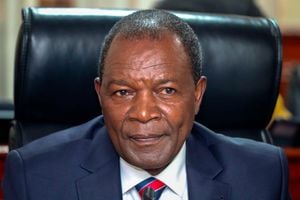
Women Enterprise Fund advanced Sh1.71 billion in the review period, falling short of the Sh2.5 billion target by nearly a third.
Small and medium-sized businesses owned by women and youthful traders missed out on millions of shillings in low-cost State loans after operations of key affirmative action funds were temporarily paralysed hurting their expansion plans.
Data released by the State Department for Micro, Small, and Medium Enterprises shows advances by Uwezo Fund and Youth Enterprise Development Fund (YEF) fell by two-thirds in the review period.
This is after women, youth, and persons living with disability accessed Sh306 million from the two funds compared with Sh948.5 million the year before, a 67.74 per cent drop.
The loans, which come with an interest of six per cent with amounts to a single borrower capped at Sh2.5 million, fell short of the Sh1.01 billion target by 69.73 per cent, according to the MSMEs department.
It has largely blamed upgrade of management systems for the funds and expiry of terms of committee members at the local level for the poor show.
This came at a time when the Ruto administration rolled out a digital financial inclusion fund, dubbed Huster Fund, which targets micro traders looking for cash to stock or restock for a day.
MSMEs department says the YEF missed the target in loan disbursements by a larger margin of 71.24 per cent compared with Uwezo’s 68.26 per cent. That was after the fund advanced some Sh143.8 million to youth-led ventures against the Sh500 million goal.
“The fund’s transition to an Enterprise Resource Planning caused delays in loan disbursements,” the MSMEs department, headed by Principal Secretary Susan Mang’eni, wrote in the sector budget report for the upcoming financial year from July.
The YEF loans in the review period represented a dip of 64.37 per cent compared with Sh403.6 million advanced in the financial year ended June 2022.
Despite the sharp fall in credit to youth-owned enterprises, the fund surpassed its target in training them on entrepreneurship skills and awareness of government priority programmes, the report says.
Some 183,421 young persons were equipped with business skills in the review period, surpassing the 100,000 goal. Additionally, the fund says 1,575 youth were facilitated to acquire jobs abroad, slightly beating 1,500 people who had been targeted.
“Leveraging on strategic partnerships and collaborations with stakeholders in the youth space to provide business development services to youth entrepreneurs contributed to the achievement of set targets,” the report states.
The youth fund was created in 2007 during the reign of former President Mwai Kibaki (deceased) alongside the Women Enterprise Fund (WEF). WEF advanced Sh1.71 billion in the review period, falling short of the Sh2.5 billion target by nearly a third (31.60 per cent).
Successive governments have instituted affirmative action funds to help MSMEs, largely owned by women and youth, to access small-ticket loans.
Despite banking industry data showing over the years that the rate of default among small businesses was lower than that for corporates, lenders continue to assign a higher risk profile to MSMEs, which usually prices them out of the formal credit market.
Findings of a 2016 survey by the Kenya National Bureau of Statistics (KNBS), for instance, suggested that about 71 per cent of the 7.4 million MSMEs in 2015 got fewer loans than they had applied from the banks, with about 86 per cent forced to rely on family and friends for funding.
In the previous regime, in which President William Ruto served as a deputy president his authority was clipped after a fallout with retired President Uhuru Kenyatta who sought to address access to funding for low-income groups through the Uwezo Fund. The fund created in 2014 sought to support enterprises owned by youth, women, and People Living with Disabilities (PWDs).
Uwezo lent out Sh162.2 million in the year ended June 2023, missing the Sh511 million target by 68.26 per cent.
“The terms of the constituency committees expired which affected loan disbursement,” the MSMEs department says.
This came at a time Dr Ruto’s Hustler Fund lent out Sh35 billion in slightly over six months following its launch in November 2022, boosted by repeat borrowers. Some 22 million persons took out loans from the financial fund, modelled around mobile digital credit providers which offer instant credit, more than double the 10 million borrowers target between November 2022 and June 2023.
Besides credit, the fund also has a built-in savings component primarily targeting those outside formal jobs.
The government contribution to the Hustler pension scheme is projected at Sh2.5 billion next financial year.
“The Hustler Fund is an instrument to correct market failures at the bottom of the pyramid,” Prof. Njuguna Ndung’u, the Treasury secretary, said at a past event. “Most of the time we start financial products to address needs at the bottom of the pyramid, but what happens is that the product leaves and moves on to the next level… whereas the intention should be that people are the ones to move upwards not the product.” Top banks like Equity and Absa Kenya have since said they will be keen on creditworthy borrowers who will graduate from Hustler Fund.
“The Hustler Fund has won our hearts because of its design around financial discipline. It is not free money. It is going to be repaid. It is a loan that you have to have credentials in terms of credit rating [to access], it forces you to have saving culture… and it reaches the masses,” Equity Group chief executive James Mwangi said in the early days of the fund. “The risk is being taken by the government. We will support it by scaling. People will graduate from Hustlers fund to private sector Hustler fund.”
To derisk the credit market for small traders, the Treasury unveiled the Credit Guarantee Scheme which covers 25 per cent of the loan in the event of default.
The Treasury has also revealed plans to set up a company in partnership with financial institutions to derisk lending to small traders, including those who graduate from Ruto’s Hustler Fund to borrowing from commercial banks.
The proposed Kenya Credit Guarantee Scheme Company (KCGSC) will guarantee a share of the loans commercial banks will advance to cash-strapped micro-, small--- and medium-sized enterprises (MSMEs).
The joint venture between the government and private sector is expected to unlock higher-value loans to individuals and groups whose financial needs will grow beyond the limits provided by the Hustler Fund – President William Ruto’s flagship financial inclusion propgramme.
“The government will continue supporting individuals and Micro, Small and Medium Enterprises (MSMEs) excluded at the bottom of the pyramid through the Financial Inclusion Fund or the Hustlers Fund,” the Treasury wrote in the draft 2024 Budget Policy Statement (BPS).
“The government will also convert the Credit Guarantee Scheme into the Kenya Credit Guarantee Scheme Company to ensure sustainability and develop a Credit Guarantee Policy whose objective is to provide a clear framework for a sustainable model for credit guarantee scheme for MSMEs.”









